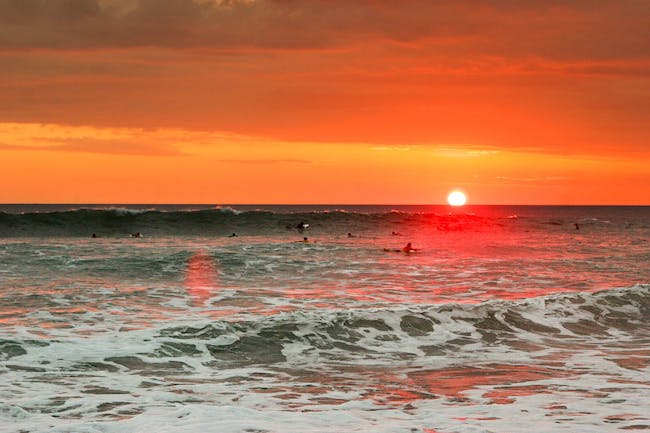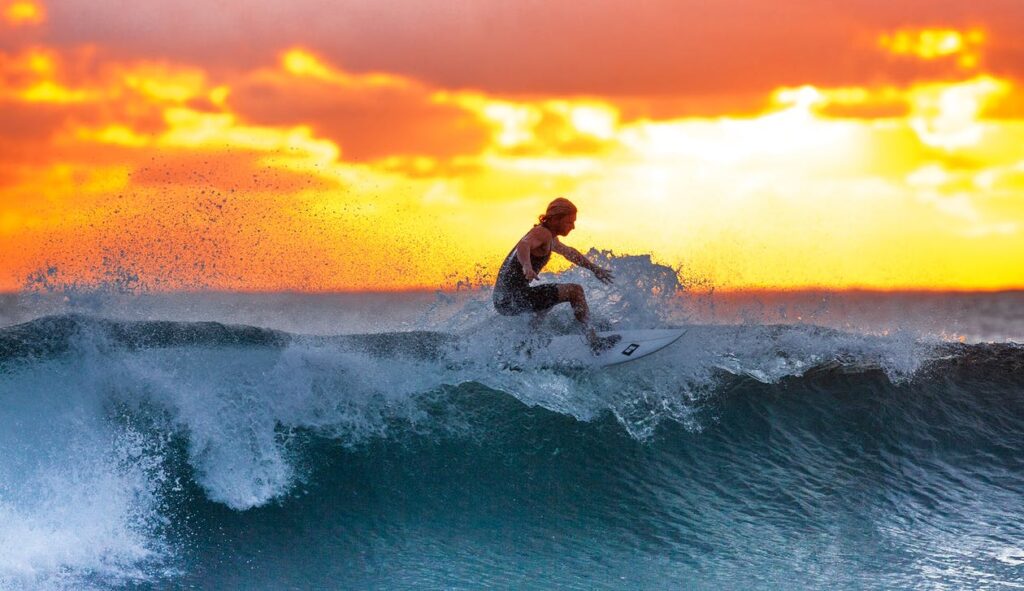When I first started surfing it was down in Costa Rica. We would be out late at night drinking the night away and then my friends would wake up at the crack of dawn to paddle out. I didn’t understand it at the time. You might be in a similar position.
Surfers surf in the morning because the wind is usually the lightest and there are usually fewer people in the water so you catch more waves. The morning isn’t always the best time to surf though.
Surfers often hit the waves early in the morning

For most people, the day begins when the alarm clock goes off. But for surfers, the day often starts long before sunrise. That’s because the best waves can be found early in the morning before the wind has had a chance to pick up and create choppy conditions. In addition, starting your day out in the water is one of the best ways to set the vibe for the day. Of course, getting up early isn’t always easy, but it’s all part of the surfer’s lifestyle. After all, catching the perfect wave is worth a few lost hours of sleep.
There are many benefits to surfing in the morning
For many people, the morning is the most productive time of day. The mind is fresh and the energy levels are high, making it the perfect time to get a head start on the day. However, for some people, the morning is a time of stress and rushing around. If this sounds familiar, then you may want to try surfing. Not only is it a great workout, but it can also help to clear your mind and start your day off on the right foot. Surfing in the morning can help you to relax and enjoy the rest of your day.
What Do Surfers Mean By Dawn Patrol?
Dawn patrol is a term used by surfers to describe the act of surfing early in the morning, usually before sunrise. Dawn patrol can be a solo affair or it can involve a group of friends. Either way, it’s a great way to start the day.
When I first learned to surf, I hated Dawn Patrol. I mainly hated it because I was out late the night before and I wasn’t a good enough surfer to understand it. As I’ve gotten older, I have grown a fondness for it.
The waves are usually calmer in the morning
The waves are usually calmer in the morning because the wind is typically less strong at that time of day. The wind is what causes the waves, so when it dies down, the waves do too. This is why calm weather is often referred to as “glass-like” conditions. The water is so still that it looks like a sheet of glass.
This can be a good time to go swimming or surfing, although if you’re a beginner you should always check with a lifeguard before entering the water. If you’re looking for a peaceful time to enjoy the ocean, the morning is usually the best time to go.
What Wind Is The Best For Surfing?
When I started surfing I remember people talking about the different wind conditions and I had no idea what any of it meant. After all, the wind was just wind, right? Oh, how wrong I was…
The truth is, that the wind plays a crucial role in the waves and the conditions of the ocean. Different winds create different waves and different surf conditions. As a result, certain winds are better for surfing than others.
So, what wind is best for surfing? The answer to this question depends on a few factors, including the type of waves you want to surf, the conditions of the ocean, and the level of your surfing ability.
In general, the best wind for surfing is offshore wind. This is because the offshore wind blows from the land out to sea. As a result, it creates waves that break away from the shore. These are the type of waves that most surfers want to ride.
Of course, not all offshore winds are created equal. The best offshore winds for surfing are those that blow at a consistent speed and direction. These conditions are typically found in the morning hours before the sea breeze picks up.
Recommended: Why Surfing Is the Ultimate Full-Body Workout
What Tide Is Best For Surfing?
Just like the wind, the tide can also have a big impact on the waves and surf conditions. The tide is the rise and fall of ocean water due to the gravitational pull of the moon. The tide might not be ideal for surfing in the morning some days. The best tide for surfing will vary from location to location.
When the tide is extremely low, you might be at a break that has exposed rocks or reefs. Some of the waves during low tide will just close out on you.
If you’re new to an area and the surf guides say that a spot gets too shallow to surf at low tide, be extra cautious. If you still see locals out there surfing, you might be able to, but be aware that it might not be safe for you. There was one time when I was out surfing at Padang Padang in Bali, Indonesia and we were basically surfing on about 2 ft of water over the reef. But I had been surfing that spot for over a month every day so felt like I knew the spot relatively well. I still got out after I realized I was standing in very shallow water after I caught my last wave.
During times of extreme high tides, you might actually not be able to catch anything because the waves are too fat. The waves just kind of roll right through. You might be better off grabbing your Stand Up Paddleboard and enjoying that.
As you know the tides change every day so some mornings it might just not be the right tide for the spot you’re surfing. The more you surf at a spot, the better you’ll learn how it reacts to different conditions.
So, what tide is best for surfing? The answer to this question depends on the type of waves you want to surf, the particular beach you surf, and your skill level.
Which Is Better For Surfing? Incoming or Outgoing Tides?
The outgoing tide is when the water is going out to sea. The incoming tide is when the water is coming back in towards the shore. So, which one is better for surfing?
In general, most surfers prefer surfing on an incoming tide. This is because the waves tend to be bigger and more powerful as they come in towards the shore.
However, there are some exceptions to this rule. Some surf spots actually work better on an outgoing tide. This is because the waves can be more consistent and longer-lasting.
In the end, it really depends on the particular beach and waves you’re surfing. The only way to know for sure is to try it out for yourself.
What Swell Size is Best for Surfing?
The swell size is the height of the waves. The ideal swell size for surfing will depend on a few factors, including the level of your ability and the type of waves you want to surf.
If you’re a beginner surfer, you’ll probably want to stick to smaller waves. This is because they’re easier to paddle into and ride. As you become more experienced, you can start surfing bigger waves.
In general for beginners, the ideal swell size for surfing is between 2-4 feet. This is because it’s big enough to create some good waves, but not too big that it becomes dangerous.
Can You Surf Before Sunrise?
The answer to this question is yes, you can surf before sunrise. It might not be a long time before the sun rises though. The daylight tends to start and light up the skies before the sun actually rises, sometimes as soon as 40-50 minutes before sunrise. You want to make sure there is enough visibility that you can actually see the waves coming.
One of the best ways to find out when you can surf is to search your local area’s first light. You can do the same with sunset sessions. As long as you can still see the waves, you can catch some. Just keep in mind that for both of these, you don’t want to be the only person out surfing in case an emergency happens.
Keep in mind that sharks tend to feed at first and last light, so if you’re in an area known for shark attacks it might be best to not paddle out at these times. As always, it’s up to you and your risk tolerance.

Is It Safe To Surf at Night?
Depending on the conditions it can be safe to surf at night. The biggest obstacle for surfing at night is visibility though. If you can’t see the waves or where you’re going, you increase your risk of getting hurt or disoriented. On nights where there is great visibility from a full moon, it can be a memorable experience. Other times you might be able to surf when there is phosphorescence in the water, which will absolutely create memories.
If you’re at a beach that’s a sandy bottom and its a clear night, you definitely can enjoy some night surfing. You just need to be aware of your surroundings and use common sense. If the conditions aren’t ideal, it’s best to stay on shore.
In conclusion, yes you can surf at night but be aware of the conditions and use common sense. Also, don’t forget to have fun!
